In my last post, I talked about our first dive of this day on the Restorer Tug site. We had planned on going to the G.A. Venturo Tug earlier in the day but our friends on the Venture III dive boat out of Shark River were there already. They left the site after one dive and we went there for our second dive of the day and what a dive it was.
The surface water was a yellowish color and very murky. I always look for ocean sunfish or turtles on the surface and if I see one, I try to get into the water for photos. With the surface water that we have now, I wouldn’t even attempt it. My dive buddy, Beth Dalzell, and I took our cameras with us on the dive. We had heard that there was twenty-five feet of visibility and we were excited. Normal visibility for inshore sites in New Jersey is fifteen feet or less. The extra ten feet makes a big difference when shooting wide angle photos. The bottom temperature on the Venturo was 55° F.
The Venturo Tug is a 99’ long Navy tugboat that was sunk on the Sea Girt Artificial Reef off Sea Girt, New Jersey on Thursday, October 17, 1996. She lies upright on a sandy bottom in 80’ of water. The site was originally sponsored by Sean Maubray & FCO. It has since been dedicated to Greg Venturo, who lost his life while SCUBA diving. This dedication was sponsored by the Fisherman’s Conservation Organization.
As I descended the anchor line, I saw Beth about twenty feet below me at the anchor which was hooked into the gunnel at the bow. I was impressed with the visibility and I was glad to have a wide angle lens on my camera.
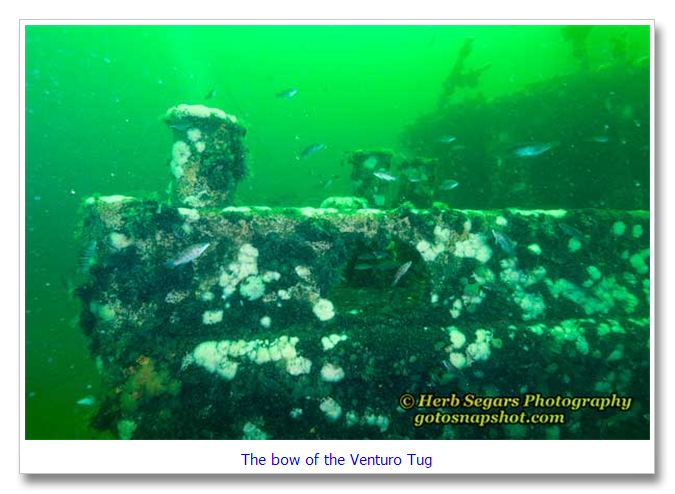
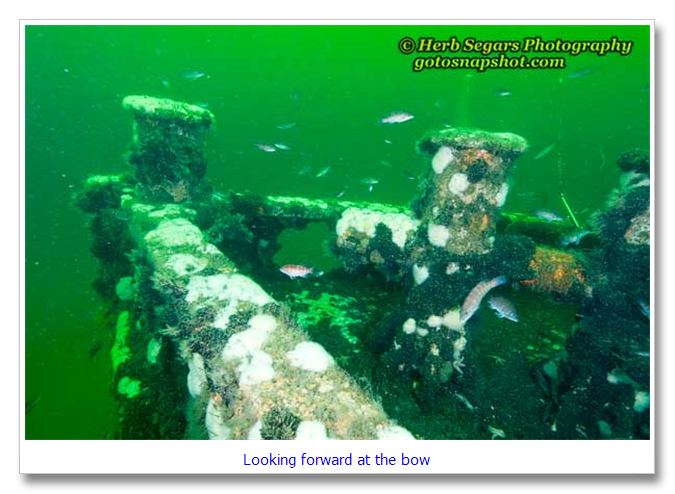
I wasted no time setting up my twin Ikelite DS-125 strobes and adjusting them so that I would get could coverage on the 12mm end of my Nikon 12-24mm wide angle lens. I started at the bow and worked my way towards the stern. Once I saw the smoke stack above the deckhouse, I couldn’t keep myself away from it. It looks so majestic sticking up into the water column. Beth was doing the same on the other side of the tug and we were totally enjoying the dive. The tug is big enough that there are plenty of things to photograph.
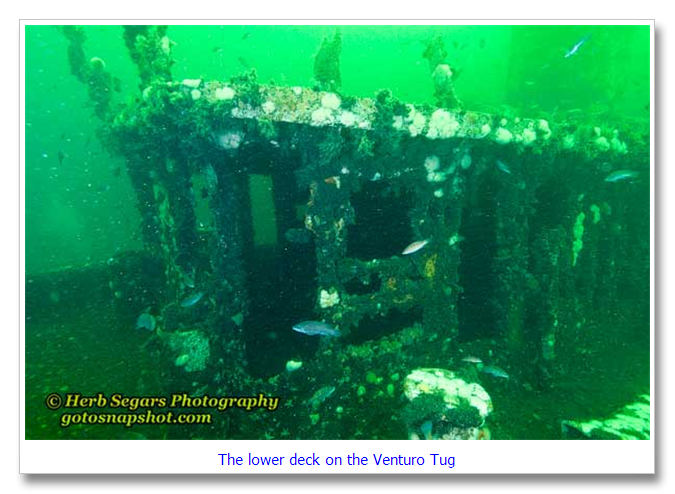
I noticed that there was a lot of deterioration to the lower deckhouse. I also noticed that the pilot house that was above the deckhouse is gone. Perhaps a dragger took it off or a storm tore it off. However it happened, it would take a lot to shear it off the tug.
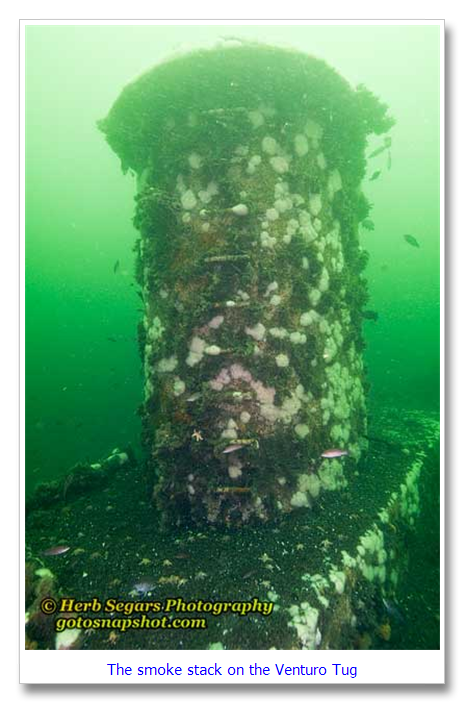
The smoke stack is located above the deckhouse behind the pilothouse. It is wild to think that the pilot house was sheared off the tug and that the smoke stack is still there.
You can still see the ladder steps that go from the roof of the deckhouse to the top of the smoke stack.
As I went around the smoke stack, I noticed some rather large holes in it where the metal is corroding.
The Venturo Tug has been on the bottom for thirteen years. I wonder how it will look in another thirteen years?
There was much less growth on the Venturo Tug than I saw on the Veronica M two weeks ago. As I stated in the Colleen Tug blog, I think that things run in cycles underwater. There were plenty of small blue mussels on the Venturo. Perhaps next year, this will be a good site to harvest mussels. Now if I only remember that next year.
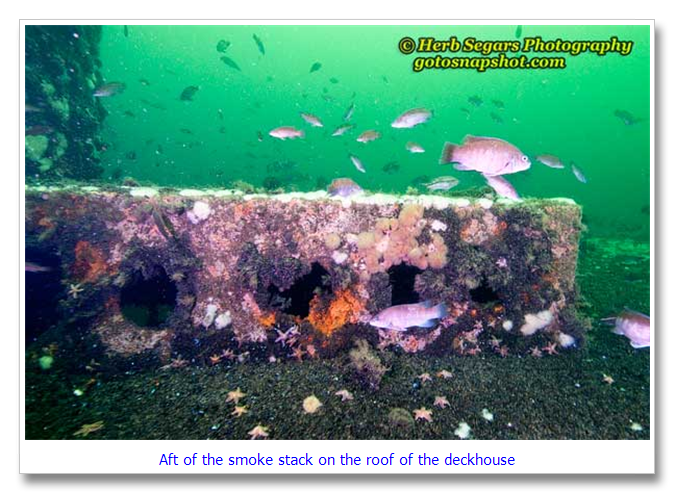
There was plenty of fish life on the tug. Bergalls (cunner) are the predominant species but I also saw plenty of black seabass and blackfish (tautog). I didn’t spend much time at the bottom so I didn’t notice whether there were any summer flounder, ling or common sea robins hanging around.
As I got to the stern on the roof of the deckhouse, I found some pretty serious damage that appeared to happen while the tug was on the bottom.
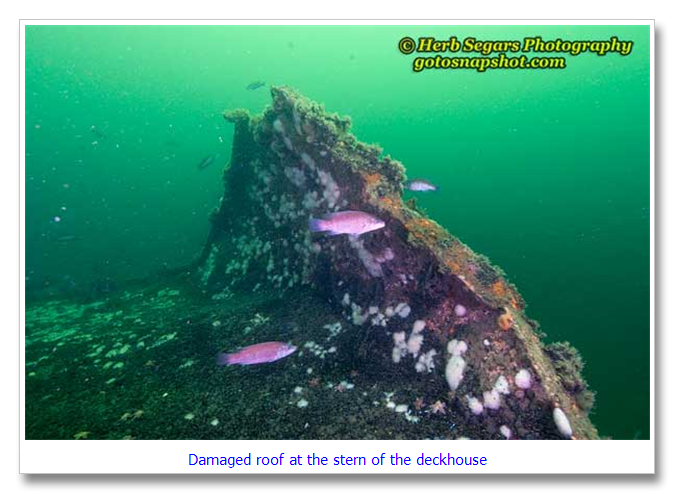
Whatever caused this damage was probably also the cause of the loss of the pilot house. I dropped down off the roof of the deckhouse onto the stern deck.
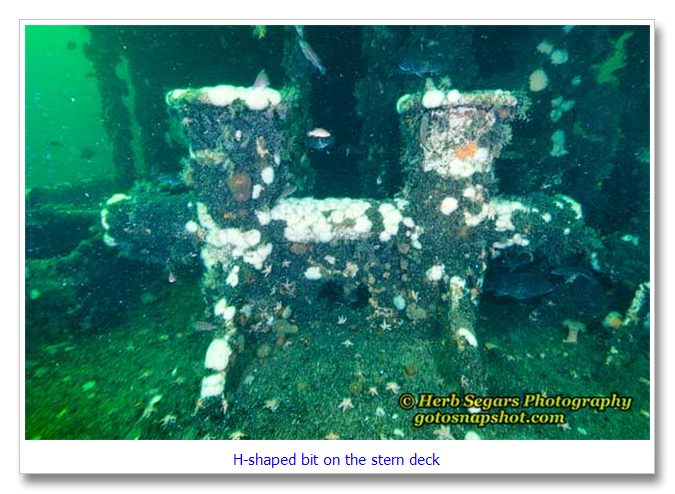
Here I found an H-shaped towing bit and a capstan located just to the right of the bit. I was really enjoying this dive. I went over the edge of the stern rail so I could get some photos of the stern.
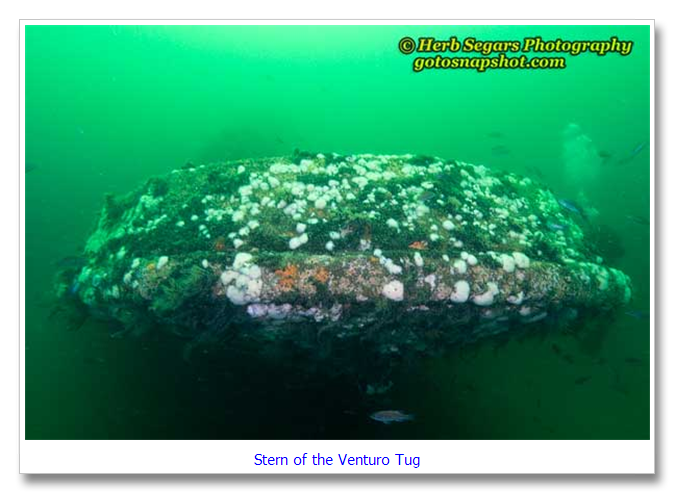
The stern was covered with frilled anemones, algae and sponge. It was a beautiful sight. I knew that the rudder is gone from the tug but that the prop is still there and it is a rather large prop – about four feet across. This is a difficult photo because there is no ambient light underneath the stern and it tends to get silted up pretty quickly but I gave it the old college try.
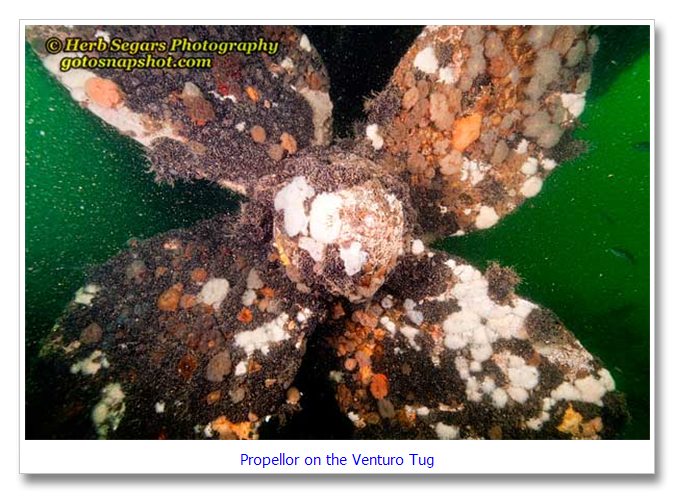
I worked my way back towards the bow and decided to take a look inside the deckhouse. There were some pretty large openings so I headed in. There were blue mussels growing everywhere. They were still small but that’s okay. They will get larger in time. I like taking photos from inside a structure so that the green water shows through doorway, window and porthole openings.
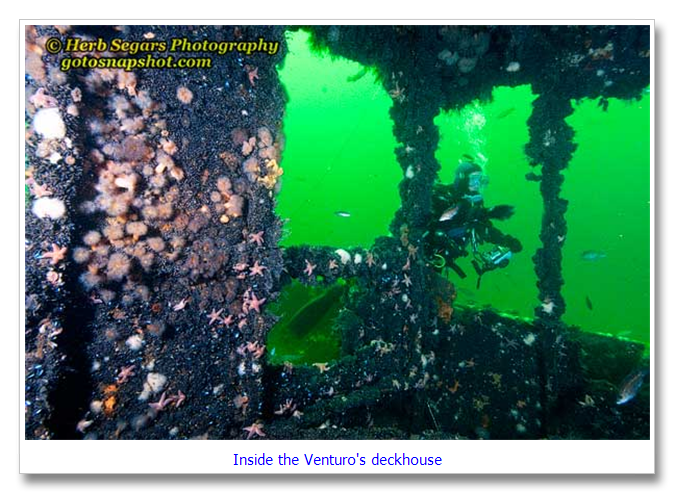
While I was in the deckhouse, my dive buddy, Beth kept a watchful eye. I tend to get so engrossed in what I am doing and Beth knows it so she makes sure that I don’t overstay my bottom time.
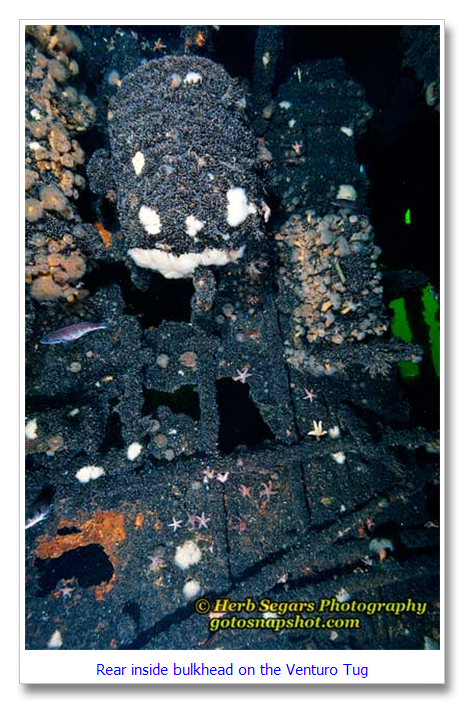
I couldn’t resist adding this photo to the blog. I took it inside the deckhouse near the stern end. As soon as my wife, Veronica, saw it she said, “Look at the smiley face!”
Once she pointed it out to me, I started to laugh and realized that she was totally correct. It does look like a smiley face.
Perhaps Greg Venturo, who was a SCUBA diver, positioned things just like that to let us know that although he is gone, he is in a better place and he’s smiling. One can only hope.
Sometimes I wonder how these things pop into my head but as I get older, I just write it off to having a few screws loose.
I exited the deckhouse near the stern and made another trip around the tug before ending the dive.
I realized that when I was shooting film, I would have stopped at 36 exposure – hoped that I had some good ones and wished that I had time to take more shots.
When conditions are good, I don’t have those limitations with digital. I wasn’t sure how many photos I had taken on this dive but I knew that I had shot a lot. I am a firm believer in maximizing opportunities. Each dive season is a crap shoot as to how many dives I make or how many times I visit each dive site or whether I visit it at all. I’ll let you know how many photos I took on this dive at the end of the blog.
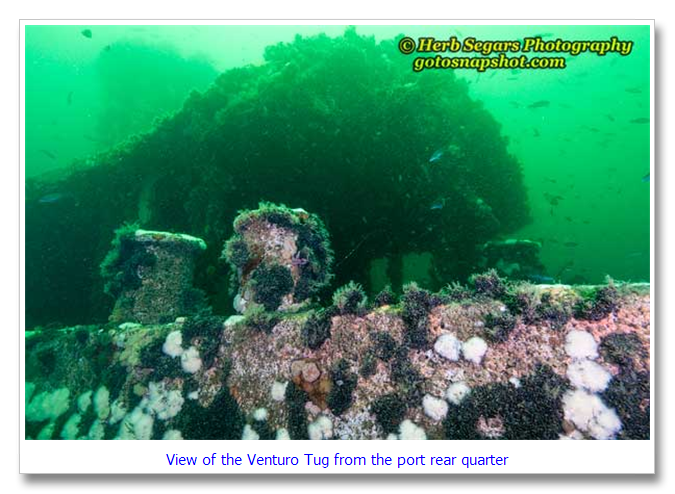
It is not often that I get the opportunity to get real wide angle photos of shipwrecks and artificial reefs in New Jersey but this is one of those times and I am as happy as a pig in a pig pen. Before I knew it, my bottom time had run out and it was time to make my way to the bow and head for the surface.
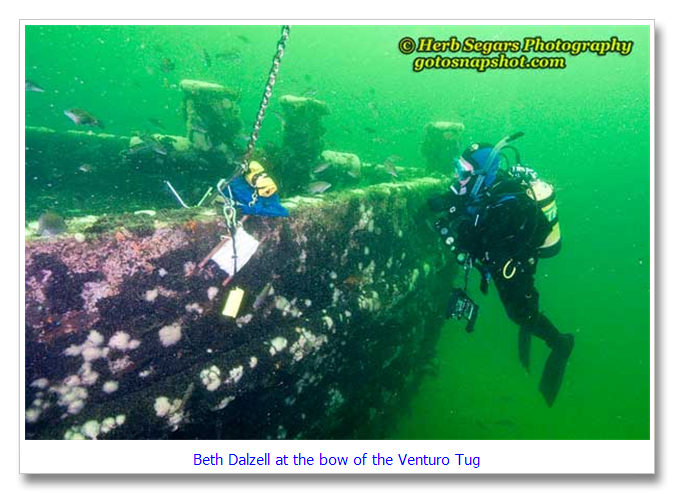
Beth and I bid our farewells to the Venturo Tug and made our way to the surface. As we were doing our safety stop at fifteen feet, I was thinking of what a great day we had. People who don’t dive can’t imagine that the Atlantic waters off the New Jersey coast have so much to offer to SCUBA divers. Conditions are not always like today but when they are, they leave a lasting impression in your mind. Even if our next trip is not as great, I know that there will be another day like this one.
Finally, how many pictures did I take? Before I tell you, digital photography presents a problem to SCUBA divers. Especially divers like me that tend to get engrossed in their photos. When I was shooting film, I always ran out of film before I ran out of air. With a 16gb memory card in my camera, that just doesn’t happen anymore. Underwater photographers have to more diligent than ever keeping track of their remaining air and bottom time. It also helps to have a great dive buddy like Beth.
When I downloaded the images from my memory card, I found that I had shot 305 images on the Venturo Tug. After going through them and eliminating ones that I didn’t like, I kept a staggering 228 images which are now on my web site. Click here to see more images of the G.A. Venturo.
© 2009, Herb Segars. All rights reserved.

